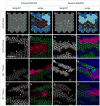Asymmetric homotypic interactions of the atypical cadherin flamingo mediate intercellular polarity signaling
- PMID: 18555784
- PMCID: PMC2446404
- DOI: 10.1016/j.cell.2008.04.048
Asymmetric homotypic interactions of the atypical cadherin flamingo mediate intercellular polarity signaling
Abstract
Acquisition of planar cell polarity (PCP) in epithelia involves intercellular communication, during which cells align their polarity with that of their neighbors. The transmembrane proteins Frizzled (Fz) and Van Gogh (Vang) are essential components of the intercellular communication mechanism, as loss of either strongly perturbs the polarity of neighboring cells. How Fz and Vang communicate polarity information between neighboring cells is poorly understood. The atypical cadherin, Flamingo (Fmi), is implicated in this process, yet whether Fmi acts permissively as a scaffold or instructively as a signal is unclear. Here, we provide evidence that Fmi functions instructively to mediate Fz-Vang intercellular signal relay, recruiting Fz and Vang to opposite sides of cell boundaries. We propose that two functional forms of Fmi, one of which is induced by and physically interacts with Fz, bind each other to create cadherin homodimers that signal bidirectionally and asymmetrically, instructing unequal responses in adjacent cell membranes to establish molecular asymmetry.
Figures







References
-
- Adler PN, Krasnow RE, Liu J. Tissue polarity points from cells that have higher Frizzled levels towards cells that have lower Frizzled levels. Curr Biol. 1997;7:940–949. - PubMed
-
- Adler PN, Taylor J, Charlton J. The domineering non-autonomy of frizzled and van Gogh clones in the Drosophila wing is a consequence of a disruption in local signaling. Mech Dev. 2000;96:197–207. - PubMed
-
- Amonlirdviman K, Khare NA, Tree DR, Chen WS, Axelrod JD, Tomlin CJ. Mathematical modeling of planar cell polarity to understand domineering nonautonomy. Science. 2005;307:423–426. - PubMed
-
- Bastock R, Strutt H, Strutt D. Strabismus is asymmetrically localised and binds to Prickle and Dishevelled during Drosophila planar polarity patterning. Development. 2003;130:3007–3014. - PubMed
Publication types
MeSH terms
Substances
Grants and funding
LinkOut - more resources
Full Text Sources
Other Literature Sources
Molecular Biology Databases

